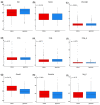Genome-Wide Association Mapping of Salinity Tolerance at the Seedling Stage in a Panel of Vietnamese Landraces Reveals New Valuable QTLs for Salinity Stress Tolerance Breeding in Rice
- PMID: 34071570
- PMCID: PMC8228224
- DOI: 10.3390/plants10061088
Genome-Wide Association Mapping of Salinity Tolerance at the Seedling Stage in a Panel of Vietnamese Landraces Reveals New Valuable QTLs for Salinity Stress Tolerance Breeding in Rice
Abstract
Rice tolerance to salinity stress involves diverse and complementary mechanisms, such as the regulation of genome expression, activation of specific ion-transport systems to manage excess sodium at the cell or plant level, and anatomical changes that avoid sodium penetration into the inner tissues of the plant. These complementary mechanisms can act synergistically to improve salinity tolerance in the plant, which is then interesting in breeding programs to pyramidize complementary QTLs (quantitative trait loci), to improve salinity stress tolerance of the plant at different developmental stages and in different environments. This approach presupposes the identification of salinity tolerance QTLs associated with different mechanisms involved in salinity tolerance, which requires the greatest possible genetic diversity to be explored. To contribute to this goal, we screened an original panel of 179 Vietnamese rice landraces genotyped with 21,623 SNP markers for salinity stress tolerance under 100 mM NaCl treatment, at the seedling stage, with the aim of identifying new QTLs involved in the salinity stress tolerance via a genome-wide association study (GWAS). Nine salinity tolerance-related traits, including the salt injury score, chlorophyll and water content, and K+ and Na+ contents were measured in leaves. GWAS analysis allowed the identification of 26 QTLs. Interestingly, ten of them were associated with several different traits, which indicates that these QTLs act pleiotropically to control the different levels of plant responses to salinity stress. Twenty-one identified QTLs colocalized with known QTLs. Several genes within these QTLs have functions related to salinity stress tolerance and are mainly involved in gene regulation, signal transduction or hormone signaling. Our study provides promising QTLs for breeding programs to enhance salinity tolerance and identifies candidate genes that should be further functionally studied to better understand salinity tolerance mechanisms in rice.
Keywords: GWAS; QTL; Vietnamese landraces; rice; salinity tolerance.
Conflict of interest statement
The authors declare no conflict of interest.
Figures



Similar articles
-
Genome-Wide Association Study (GWAS) to Identify Salt-Tolerance QTLs Carrying Novel Candidate Genes in Rice During Early Vegetative Stage.Rice (N Y). 2021 Jan 9;14(1):9. doi: 10.1186/s12284-020-00433-0. Rice (N Y). 2021. PMID: 33420909 Free PMC article.
-
Genome-wide Association Study of a Panel of Vietnamese Rice Landraces Reveals New QTLs for Tolerance to Water Deficit During the Vegetative Phase.Rice (N Y). 2019 Jan 28;12(1):4. doi: 10.1186/s12284-018-0258-6. Rice (N Y). 2019. PMID: 30701393 Free PMC article.
-
Molecular Dissection of Seedling Salinity Tolerance in Rice (Oryza sativa L.) Using a High-Density GBS-Based SNP Linkage Map.Rice (N Y). 2016 Dec;9(1):52. doi: 10.1186/s12284-016-0125-2. Epub 2016 Oct 1. Rice (N Y). 2016. PMID: 27696287 Free PMC article.
-
Salt tolerance in rice: seedling and reproductive stage QTL mapping come of age.Theor Appl Genet. 2021 Nov;134(11):3495-3533. doi: 10.1007/s00122-021-03890-3. Epub 2021 Jul 21. Theor Appl Genet. 2021. PMID: 34287681 Free PMC article. Review.
-
Unlocking Allelic Diversity for Sustainable Development of Salinity Stress Tolerance in Rice.Curr Genomics. 2021 Dec 30;22(6):393-403. doi: 10.2174/1389202922666211005121412. Curr Genomics. 2021. PMID: 35340363 Free PMC article. Review.
Cited by
-
Genome-Wide Association Study (GWAS) and genome prediction of seedling salt tolerance in bread wheat (Triticum aestivum L.).BMC Plant Biol. 2022 Dec 13;22(1):581. doi: 10.1186/s12870-022-03936-8. BMC Plant Biol. 2022. PMID: 36513980 Free PMC article.
-
Salinity stress tolerance and omics approaches: revisiting the progress and achievements in major cereal crops.Heredity (Edinb). 2022 Jun;128(6):497-518. doi: 10.1038/s41437-022-00516-2. Epub 2022 Mar 5. Heredity (Edinb). 2022. PMID: 35249098 Free PMC article. Review.
-
Gene Mapping, Cloning and Association Analysis for Salt Tolerance in Rice.Int J Mol Sci. 2021 Oct 28;22(21):11674. doi: 10.3390/ijms222111674. Int J Mol Sci. 2021. PMID: 34769104 Free PMC article. Review.
-
A comprehensive review on rice responses and tolerance to salt stress.Front Plant Sci. 2025 Mar 31;16:1561280. doi: 10.3389/fpls.2025.1561280. eCollection 2025. Front Plant Sci. 2025. PMID: 40230606 Free PMC article. Review.
-
Genetic Structure and Geographical Differentiation of Traditional Rice (Oryza sativa L.) from Northern Vietnam.Plants (Basel). 2021 Oct 3;10(10):2094. doi: 10.3390/plants10102094. Plants (Basel). 2021. PMID: 34685903 Free PMC article.
References
-
- Rengasamy P. Soil Processes Affecting Crop Production in Salt-Affected Soils. Funct. Plant Biol. 2010;37:613. doi: 10.1071/FP09249. - DOI
-
- Wassmann R., Nelson G., Peng S., Sumfleth K., Jagadish K., Hosen Y., Rosegrant M. Rice in the Global Economy: Strategic Research and Policy Issues for Food Security. IRRI; Los Banos, Philippines: 2010. Rice and global climate change; pp. 411–433.
-
- Timmer C.P., Block S., Dawe D. Rice in the Global Economy: Strategic Research and Policy Issues for Food Security. IRRI; Los Banos, Philippines: 2010. Long-run dynamics of rice consumption, 1960–2050; pp. 139–174.
-
- Sarah K.B. System of Rice Intensification in Vietnam: Doing More with Less. Oxfam: Food and Agriculture Organisation of the United States; Washington, DC, USA: 2016. 52 Profiles on Agroecology.
-
- Ngoc Huyen Việt Nam chịu ảnh hưởng ra sao bởi biến đổi khí hậu? [(accessed on 24 May 2021)];Báo Đồng Khởi. 2008 Available online: https://baodongkhoi.vn/viet-nam-chiu-anh-huong-ra-sao-boi-bien-doi-khi-h....
Grants and funding
LinkOut - more resources
Full Text Sources

